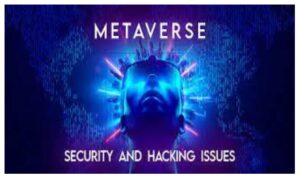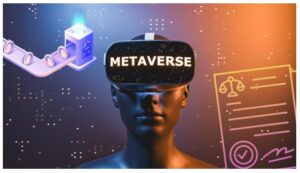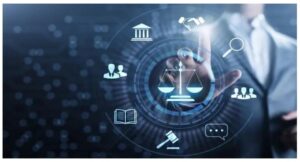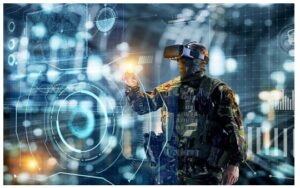CYBERSECURITY IN THE METAVERSE

A Hollywood movie that depicts a scenario related to Cybersecurity in the metaverse is “Ready Player One”. The movie is set in the year 2045 when the world is on the brink of chaos and collapse. But the people have found salvation in the OASIS, an expansive virtual reality universe created by the brilliant and eccentric James Halliday. When Halliday dies, he leaves his immense fortune to the first person to find a digital Easter egg he has hidden somewhere in the OASIS, sparking a contest that grips the entire
world. Wade Watts, an unlikely young hero, decides to join the contest and embarks on a reality-bending treasure hunt through a fantastical universe of mystery, discovery and danger.

In the end, Wade and his friends can find the Easter egg and win the game, and as a result, they gain control of the OASIS and Halliday’s company. They then use this power to make the OASIS a more inclusive and equitable place for everyone, rather than just a tool for profit. They also open a virtual school to help people from all over the world to get access to education.
In the final scene of the movie, Wade, in his virtual avatar, sits on a virtual stage, surrounded by his friends and fellow players, as he declares the OASIS is open to all, and that the contest is over. The movie ends on a happy note, with Wade and his friends having achieved their goal and changing the world for the better.

Cybersecurity in the Metaverse refers to the protection of virtual reality and augmented reality environments from unauthorized access, theft, damage, or disruption. This includes protecting user data, identities, and assets within the Metaverse, as well as ensuring the integrity and reliability of the underlying technology. As the metaverse becomes an increasingly important aspect of our lives, we must ensure its security. One major concern in the metaverse is the potential for hackers to access and steal personal information, such as financial data or sensitive documents. Additionally, malicious actors may use the metaverse as a platform to launch cyberattacks on the physical world, such as through the manipulation of virtual objects to disrupt critical infrastructure. Key challenges in Metaverse cybersecurity include dealing with a wide range of potential attack vectors, such as hacking, malware, and phishing, as well as addressing the unique security needs of virtual and augmented reality environments. Additionally, as the Metaverse continues to evolve, new security risks and challenges will likely emerge, requiring ongoing attention and adaptation to stay ahead of potential threats.
To address these concerns, it is important to implement robust security measures in the metaverse. This can include the use of encryption to protect data, the implementation of security protocols to prevent unauthorized access, and the development of tools to detect and respond to cyber threats.
As the metaverse continues to evolve, it will be important for individuals and organizations to stay informed about the latest developments in cybersecurity and to take proactive steps to protect themselves and their digital assets.

What challenges can we foresee for Metaverse in the coming days?
As the Metaverse continues to evolve, there are several challenges that may arise in the coming days. These include:
- Cybersecurity: As the Metaverse becomes more popular and widely adopted, the risk of cyber attacks and data breaches will likely increase. Ensuring the security and privacy of users’ data and virtual assets will be a critical challenge.
- Scalability: As more people and businesses adopt the Metaverse, the need for scalable and resilient infrastructure will become increasingly important. This will require significant investments in cloud computing, edge computing and distributed systems.
- Interoperability: As the Metaverse continues to grow and evolve, it will likely become increasingly fragmented, with different platforms and environments that are not compatible with each other. Ensuring interoperability across different Metaverse environments will be a key challenge.
- Regulation: With the increasing popularity and importance of the Metaverse, governments and regulators are likely to take a closer look at this technology and the various issues that it raises, such as data protection, privacy, and intellectual property. Ensuring compliance with existing and future laws and regulations will be a key challenge.
- User experience: As the Metaverse becomes more popular, the expectations of users will also increase. Ensuring a seamless and immersive user experience will be a critical challenge.
- Economic and social impact: The Metaverse could potentially have a significant impact on the economy, labor market, and social interactions. Understanding and

How to prevent unauthorized access, theft, damage or disruption in VR and AR environments of the Metaverse
There are several ways to prevent unauthorized access, theft, damage, or disruption in the VR and AR environments of the Metaverse:
- Access control: Implementing strong authentication and authorization mechanisms to ensure that only authorized individuals can access the Metaverse environments.
- Encryption: Encrypting sensitive data and communication to protect against hacking and data breaches.
- Network security: Securing the network infrastructure that supports the Metaverse to prevent unauthorized access, denial-of-service attacks, and other network-based threats.
- Asset protection: Implementing measures to protect virtual assets within the Metaverse, such as digital rights management (DRM) and other forms of copy protection.
- User education: Educating users on best practices for staying safe within the Metaverse, such as avoiding phishing scams, being cautious about sharing personal information, and reporting any suspicious activity.
- Continuous monitoring: Setting up continuous monitoring and threat detection systems to detect and respond to security incidents quickly.
- Regular security audit: Performing regular security audits and vulnerability assessments to identify and address any vulnerabilities that may exist in the Metaverse environment.
- Collaboration: Collaborating with other stakeholders in the Metaverse ecosystem to share information, best practices, and technologies that can help to improve the security of the Metaverse.
It’s also important to be aware of the fast-paced development of technology, regulations and laws, as well as the different actors in the Metaverse ecosystem and how they may impact the security of the Metaverse.

How to ensure the integrity and reliability of underlying technology in the Metaverse
There are several ways to ensure the integrity and reliability of underlying technology in the Metaverse:
- Software updates and patch management: Keeping all software and systems up to date with the latest security patches and updates to address any known vulnerabilities.
- Quality assurance: Implementing rigorous testing and quality assurance processes to ensure that all Metaverse technology is reliable and free of defects.
- Redundancy and failover: Implementing redundancy and failover mechanisms to ensure that the Metaverse can continue to operate even in the event of a failure or outage.
- Network monitoring: Continuously monitoring the performance and health of the Metaverse network to detect and address any issues that may arise.
- Compliance and standards: Adhering to relevant industry standards and regulations to ensure that the Metaverse technology is secure and reliable.
- Third-party risk management: Managing third-party risks, such as vendors and partners that have access to the Metaverse technology, to ensure that they are following best practices and adhering to security standards.
- Incident management: Having an incident management plan in place to quickly respond to and resolve any incidents that may occur.
- Regular maintenance: Regularly maintaining and inspecting the underlying technology to ensure that it is functioning properly and that any issues are identified and addressed on time.
- Collaboration: Collaborating with other stakeholders in the Metaverse ecosystem, such as developers, vendors and partners, to share information, best practices, and technologies that can help to improve the reliability of the Metaverse technology.
It’s also important to be aware of new technologies and advancements in the field of VR and AR, and how they can impact the integrity and reliability of the Metaverse technology.

How to overcome the challenge of hacking in the Metaverse
Hacking is a significant challenge in the Metaverse, as hackers may attempt to access sensitive data, steal virtual assets, or disrupt the Metaverse environment. To overcome this challenge, several steps can be taken:
- Access control: Implement strong authentication and authorization mechanisms to ensure that only authorized individuals can access the Metaverse environments. This can include multi-factor authentication and role-based access controls.
- Encryption: Encrypt sensitive data and communication to protect against hacking and data breaches. This can include end-to-end encryption and the use of secure protocols such as HTTPS.
- Network security: Secure the network infrastructure that supports the Metaverse to prevent unauthorized access, denial-of-service attacks, and other network-based threats. This can include firewalls, intrusion detection systems, and virtual private networks (VPNs).
- Security testing: Regularly testing the Metaverse environment for vulnerabilities to identify and address any potential weaknesses that could be exploited by hackers. This can include penetration testing, vulnerability scanning and code review.
- User education: Educate users on best practices for staying safe within the Metaverse, such as avoiding phishing scams, being cautious about sharing personal information, and reporting any suspicious activity.
- Continuous monitoring: Set up continuous monitoring and threat detection systems to detect and respond to security incidents quickly. This can include monitoring network traffic, and logs and using threat intelligence.
- Incident management: Have an incident management plan in place to quickly respond to and resolve any incidents that may occur. This can include incident response teams and incident communication plans.
- Collaboration: Collaborate with other stakeholders in the Metaverse ecosystem to share information, best practices, and technologies that can help to improve the security of the Metaverse.
It’s also important to be aware of new types of hacking techniques and the fast-paced development of technology, regulations and laws that may impact the security of the Metaverse and adapt accordingly.

How to overcome the challenge of Phishing and malware in the Metaverse
Phishing and malware are significant challenges in the Metaverse, as they can be used to steal user information, disrupt the Metaverse environment, or compromise virtual assets. To overcome these challenges, several steps can be taken:
- User education: Educating users on how to identify and avoid phishing and malware scams, such as being wary of suspicious links or attachments, and never sharing personal information or login credentials.
- Email and web filtering: Implementing email and web filtering to block malicious links and attachments, and to prevent phishing emails from reaching users.
- Anti-malware: Implementing anti-malware software on all devices that access the Metaverse, to detect and remove malware that may have been downloaded.
- Network security: Implementing network security measures such as firewalls, intrusion detection systems, and virtual private networks (VPNs) to protect against malware and phishing attacks.
- Continuous monitoring: Setting up continuous monitoring and threat detection systems to detect and respond to security incidents quickly. This can include monitoring network traffic, and logs and using threat intelligence.
- Incident management: Having an incident management plan in place to quickly respond to and resolve any incidents that may occur. This can include incident response teams and incident communication plans.
- Regular security audit: Performing regular security audits and vulnerability assessments to identify and address any vulnerabilities that may exist in the Metaverse environment.
- Collaboration: Collaborating with other stakeholders in the Metaverse ecosystem to share information, best practices, and technologies that can help to improve the security of the Metaverse.
It’s also important to be aware of new types of phishing and malware techniques and the fast-paced development of technology, regulations and laws that may impact the security of the Metaverse and adapt accordingly.

What are the other challenges in the Metaverse and how to overcome it :
The Metaverse is a complex and rapidly evolving field, and as such, many challenges need to be overcome to ensure its successful development and adoption. Some other key challenges include:
- Scalability: Ensuring that the Metaverse can handle a large number of users and transactions that are expected to occur within it. This can be achieved by using distributed systems, cloud computing, and other scalability techniques.
- Interoperability: Ensuring that different Metaverse environments and platforms can interact seamlessly with each other. This can be achieved by using open standards and protocols and by collaborating with other stakeholders in the Metaverse ecosystem.
- Latency: Minimizing the latency or lag time between actions and their corresponding results in the Metaverse. This can be achieved by using low-latency networks, edge computing and distributed systems.
- Privacy and data protection: Ensuring that users’ personal information and data are protected within the Metaverse. This can be achieved by using encryption, access controls, and compliance with relevant data protection regulations.
- User experience: Ensuring that the Metaverse provides a seamless and immersive user experience. This can be achieved by using advanced VR and AR technologies, and by involving users in the design and development process.
- Cost: Ensuring that the Metaverse is accessible and affordable for users and businesses. This can be achieved by using cost-effective technologies and by creating revenue models that are sustainable for the ecosystem.
- Regulation and Compliance: Ensuring that the Metaverse is compliant with existing and future laws and regulations that may apply to it. This can be achieved by closely monitoring and adapting to the development of laws, regulations and standards in the field.
- Trust and reputation: Building trust and reputation

How can the Metaverse be policed and regulated?
Policing and regulating the Metaverse can be a complex task, as it involves a wide range of issues such as privacy, cybersecurity, intellectual property, and user safety. However, several steps can be taken to help ensure a safe and secure Metaverse for all users.
- Self-regulation: Encouraging Metaverse developers and operators to implement industry-wide best practices and guidelines for security, privacy, and user safety. This can include creating a code of conduct for users, and implementing internal compliance and auditing processes.
- Technical solutions: Implementing technical solutions such as encryption, access controls, and continuous monitoring to help protect users’ data and virtual assets.
- Compliance with existing laws and regulations: Ensuring that the Metaverse complies with existing laws and regulations such as data protection, privacy, and intellectual property laws. This can include regular auditing and compliance reporting.
- Cooperation with law enforcement: Building relationships with law enforcement agencies to help identify and prosecute individuals who engage in illegal activities within the Metaverse.
- Public education: Educating the public about the risks and benefits of the Metaverse and how to stay safe while using it.
- International cooperation: Coordinating with other governments and international organizations to help establish consistent standards and regulations for the Metaverse.
- Monitoring and reporting system: Setting up a reporting system for users to report any suspicious activities and establish a monitoring system to track any suspicious activities and respond accordingly.
- Partnership with private sector: Partnering with private sector companies and organizations to share information, best practices, and technologies that can help to improve the

Who should police the Metaverse? What kind of law enforcement should we enforce?
Policing the Metaverse can involve a wide range of stakeholders, including government agencies, law enforcement, Metaverse developers and operators, and private sector companies. The specific role and responsibilities of each stakeholder will depend on the nature of the problem and the jurisdiction in which it occurs.
- Government agencies: Government agencies, such as the Federal Bureau of Investigation (FBI) and the Department of Justice (DOJ), may be responsible for enforcing laws and regulations related to cybercrime, intellectual property, and other issues that arise within the Metaverse.
- Law enforcement: Traditional law enforcement agencies, such as police departments, may play a role in investigating and prosecuting crimes that occur within the Metaverse. This can include crimes such as fraud, theft, and harassment.
- Metaverse developers and operators: Metaverse developers and operators may be responsible for ensuring that their platforms comply with existing laws and regulations and for implementing security measures to protect users’ data and virtual assets. They may also be responsible for cooperating with law enforcement agencies when investigating crimes that occur within their platforms.
- Private sector companies: Private sector companies, such as cybersecurity firms, may play a role in helping to protect the Metaverse from cyber threats and in investigating and responding to incidents when they occur.
- International cooperation: As the Metaverse is a global phenomenon, international cooperation will be crucial in policing the Metaverse. This can include sharing
information and best practices, and coordinating investigations across different jurisdictions. - Virtual law enforcement agencies: As the Metaverse becomes more popular, it’s likely that specialized virtual law enforcement agencies will emerge to help police the Metaverse. These agencies may be responsible for enforcing laws and regulations within the Metaverse, and may also be responsible for investigating and responding to incidents that occur within the Metaverse.
- Virtual courts: As the Metaverse becomes more

What kind of judicial system would we operate in the Metaverse?
Virtual courts refer to legal systems that operate within the Metaverse, where disputes and crimes can be resolved through virtual proceedings and trials. These virtual courts can be used to resolve disputes that arise within the Metaverse, such as disputes over virtual property, intellectual property, or contract violations. They can also be used to prosecute crimes that occur within the Metaverse, such as cybercrime and harassment. Virtual courts can be beneficial in several ways:
- Accessibility: Virtual courts can make the legal system more accessible to people who live in remote or underserved areas, or who have physical or mobility limitations.
- Speed: Virtual courts can resolve disputes and prosecute crimes in a faster and more efficient manner than traditional courts, which can save time and money for all parties involved.
- Cost-effective: Virtual courts can be more cost-effective than traditional courts, as they do not require the expensive infrastructure and resources that traditional courts do.
- Jurisdiction: Virtual courts can help to resolve disputes and crimes that cross national borders, as they can operate within the Metaverse regardless of the physical location of the parties involved.
However, there are also some challenges that virtual courts will have to overcome.
- Jurisdiction: As virtual courts operate within the Metaverse, it may be difficult to determine the jurisdiction in which a dispute or crime occurred, and to enforce decisions made by virtual courts.
- Legal expertise: It may be difficult to find legal experts with the necessary knowledge and experience to preside over virtual court cases.
- Technical expertise: Virtual courts will require advanced technical expertise to operate, which may be difficult to find or afford.
- Enforcing decisions: Enforcing decisions made by virtual courts may

What kind of law enforcement would be needed in the Metaverse ?
It is possible that there could be virtual police stations and patrols in the Metaverse, similar to the real world. These virtual police stations and patrols could be used to help ensure the safety and security of Metaverse users and to investigate and respond to crimes and other incidents that occur within the Metaverse.
- Virtual police stations: Virtual police stations could serve as a point of contact for users to report crimes and other incidents, and for law enforcement to investigate and respond to them. These virtual police stations could also serve as a hub for information sharing and coordination with other law enforcement agencies.
- Virtual patrols: Virtual patrols could be used to monitor the Metaverse for suspicious activities and to respond to incidents in real-time. These virtual patrols could be conducted by virtual law enforcement officers, who could use virtual reality technology to navigate the Metaverse and interact with users.
- Real-time monitoring: Virtual patrols could also use real-time monitoring tools such as AI-driven surveillance systems, which would help to detect and respond to suspicious activities and crimes in real-time.
- Virtual forensic tools: Virtual police stations and patrols may also have access to virtual forensic tools that can be used to collect and analyze digital evidence from virtual environments.
However, it’s important to note that virtual police stations and patrols will have to navigate some of the same challenges as virtual courts, such as jurisdiction and enforcing decisions. Additionally, it will be important to ensure that virtual police stations and patrols are used in a way that respects users’ privacy and civil liberties.

Metaverse would be global. What would be the way out for police to overcome jurisdictional issues?
Jurisdictional issues can be a significant challenge in policing the Metaverse, as crimes and incidents that occur within the Metaverse may involve parties from different countries and legal jurisdictions. However, there are several steps that can be taken to help overcome these issues:
- International cooperation: Establishing international agreements and protocols for sharing information and coordinating investigations across different jurisdictions. This can include creating a network of virtual law enforcement agencies that can share information and collaborate on investigations.
- Extradition agreements: Establishing extradition agreements with other countries to help ensure that individuals who commit crimes within the Metaverse can be brought to justice, regardless of their physical location.
- Jurisdiction-agnostic approach: Implementing a jurisdiction-agnostic approach to investigating and responding to crimes within the Metaverse. This can include using virtual forensic tools that can collect and analyze digital evidence from virtual environments, regardless of the physical location of the parties involved.
- Virtual jurisdiction: Creating virtual jurisdiction where the Metaverse will be considered as its own jurisdiction, allowing virtual law enforcement agencies and virtual courts to operate within it, and to have authority over the disputes and crimes that occur within it.
- Virtual jurisdiction laws: Having specific laws for the Metaverse that can govern the behavior of the users, and that can be enforced by virtual law enforcement agencies and virtual courts.
- User-generated content: Implementing user-generated content policies and procedures that can be used to identify

How will real-world police deal with a jurisdictional mismatch with the virtual jurisdictions?
Dealing with jurisdictional mismatches between real-world and virtual jurisdictions can be a complex issue. Here are a few ways real-world police could address this challenge:
- Coordination with virtual law enforcement agencies: Real-world police could work closely with virtual law enforcement agencies, such as those operating within the Metaverse, to share information and coordinate investigations. This could include establishing protocols for sharing digital evidence, and for coordinating extraditions or other legal proceedings.
- Jurisdiction-agnostic approach: Real-world police could also adopt a jurisdiction-agnostic approach to investigating and responding to crimes that occur within the Metaverse. This could include using virtual forensic tools to collect and analyze digital evidence, regardless of the physical location of the parties involved.
- International cooperation: Real-world police could also cooperate with law enforcement agencies from other countries to investigate and prosecute crimes that occur within the Metaverse, regardless of the physical location of the parties involved.
- Virtual jurisdiction laws: Real-world police could also familiarize themselves with the laws and regulations that apply to the Metaverse, and work to understand how these laws may differ from laws that apply to the physical world.
- Virtual jurisdiction treaty: Real-world police could also push for a treaty that would be signed by multiple countries that would recognize the virtual jurisdiction and the laws enforced there, and help in the cooperation between the real world and virtual jurisdictions.

Who will legislate the laws for the virtual jurisdictions?
Crimes that occur within the Metaverse, such as virtual murders or theft, can have real-world consequences. Here are a few potential solutions to address these issues:
- Virtual forensic tools: Law enforcement agencies can use virtual forensic tools to investigate crimes that occur within the Metaverse and to collect digital evidence. These tools can be used to identify suspects and to link virtual crimes to real-world individuals.
- Extradition agreements: Establishing extradition agreements with other countries can help ensure that individuals who commit crimes within the Metaverse can be brought to justice, regardless of their physical location.
- Virtual jurisdiction laws: Having specific laws for the Metaverse that govern the behavior of users and that can be enforced by virtual law enforcement agencies and virtual courts.
- Real-world prosecution: Real-world courts can prosecute individuals who commit crimes within the Metaverse if the crime has real-world consequences.
- Virtual-real world evidence coordination: Real-world police could work closely with virtual law enforcement agencies, such as those operating within the Metaverse, to share information and coordinate investigations. This could include establishing protocols for sharing digital evidence, and for coordinating extraditions or other legal proceedings.
- User-generated content: Implementing user-generated content policies and procedures that can be used to identify and remove content that incites or glorifies violence, hate speech or other illegal activities.
- Virtual-real world awareness: Raising awareness among virtual users of the potential real-world consequences of their actions within the Metaverse and encouraging them to act responsibly and legally.
It’s important to note that this is a complex issue and that multiple solutions may be needed to address it effectively.
Legislating laws for virtual jurisdictions, such as the Metaverse, can be a complex and evolving process. The entities that will legislate the laws for virtual jurisdictions may include:
- Governments: Governments at the national, regional or local level may take the lead in creating laws and regulations that apply to the Metaverse. These laws may be similar to existing laws that apply to the physical world, but may also include new laws that are specific to the virtual environment.
- Industry groups: Industry groups, such as technology companies and gaming organizations, may also play a role in creating laws and regulations for the Metaverse. These laws may be focused on protecting the rights of users and the integrity of the virtual environment, and may be designed to encourage innovation and growth within the Metaverse.
- International Organizations: International organizations such as the United Nations and the European Union may also play a role in creating laws and regulations for the Metaverse. These laws may be focused on ensuring that the Metaverse is used for the benefit of all people, and may be designed to promote peace, security, and human rights within the Metaverse.
- Virtual community: The virtual community could also play a role in creating laws and regulations for the Metaverse. This could include community-generated content policies, and user-generated codes of conduct.
It’s important to note that the laws and regulations that apply to the Metaverse may evolve over time as the technology and use cases for the Metaverse continue to evolve.
CONCLUSION:
In conclusion, Cybersecurity in the Metaverse is a critical issue that deserves our attention as virtual and augmented reality environments become increasingly important in our lives. With the potential for hackers to access personal information, steal assets and launch cyberattacks on the physical world, it is crucial to implement robust security measures to protect users and their digital assets.

This includes the use of encryption to protect data, the implementation of security protocols to prevent unauthorized access, and the development of tools to detect and respond to cyber threats. It’s also essential for individuals and organizations to stay informed about the latest developments in Metaverse cybersecurity and take proactive steps to ensure their safety and security.
However, as the Metaverse continues to evolve, new security risks and challenges are bound to emerge. This highlights the need for ongoing attention and adaptation to stay ahead of potential threats. The metaverse has enormous potential to enrich our lives, but we must also ensure that it is a safe and secure environment for everyone to use and enjoy.
 Dr K. Jayanth Murali is a retired IPS officer and a Life Coach. He is the author of four books, including the best-selling 42 Mondays. He is passionate about painting, farming, and long-distance running . He has run several marathons and has two entries in the Asian book of Records in full and half marathon categories. He lives with his family in Chennai, India. When he is not running, he is either writing or chilling with a book.
Dr K. Jayanth Murali is a retired IPS officer and a Life Coach. He is the author of four books, including the best-selling 42 Mondays. He is passionate about painting, farming, and long-distance running . He has run several marathons and has two entries in the Asian book of Records in full and half marathon categories. He lives with his family in Chennai, India. When he is not running, he is either writing or chilling with a book.
